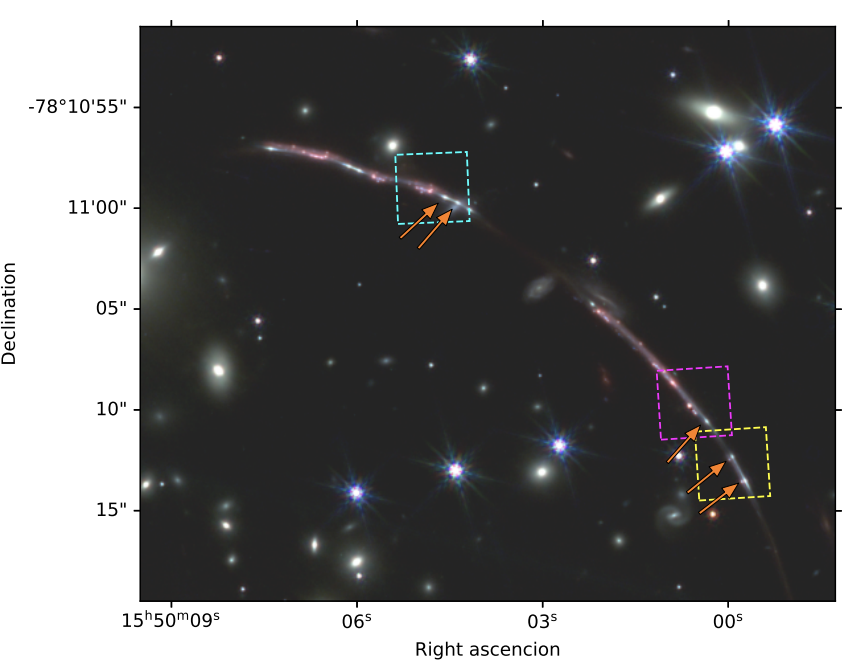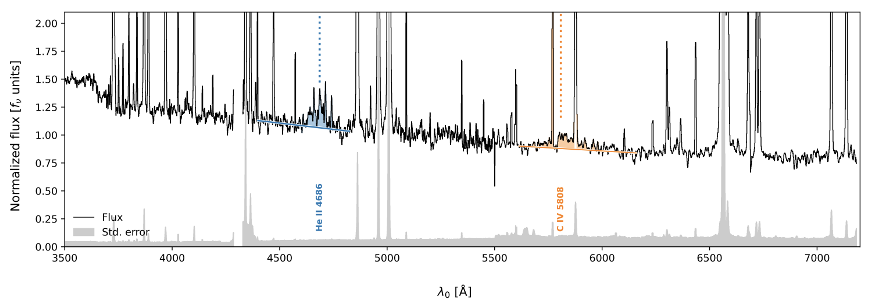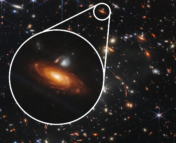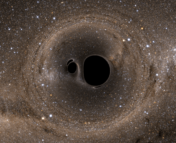Authors: T. Emil Rivera-Thorsen, J. Chisholm, B. Welch, J. R. Rigby, T. Hutchison, M. Florian, K. Sharon, S. Choe, H. Dahle, M. B. Bayliss, G. Khullar, M. Gladders, M. Hayes, A. Adamo, M. R. Owens, and K. Kim
First Author’s Institution: The Oskar Klein Centre, Department of Astronomy, Stockholm University, AlbaNova 10691, Stockholm, Sweden
Status: Submitted to A&A [open access]
A few years ago, a very interesting galaxy was discovered ‘serendipitously’ (a fancy word that means we found it completely by accident) from an image targeting the galaxy cluster PSZ1 G311.65−18.48. Ironically, this surprise galaxy is both incredibly bright and has been copied twelve times in the sky, thanks to a peculiar quirk of gravity. Nicknamed the Sunburst Arc, this galaxy is amongst the brightest gravitationally lensed galaxies discovered to date, and we now know that it is an impressive 11 billion light years away from us – i.e., the light from this galaxy is billions of years old. Thanks to the massive gravitational field of the foreground galaxy cluster acting as a gravitational lens, the light from the Sunburst Arc has been brightened, copied and bent into the arc-like shape that inspired its name. Along four arcs around the central cluster, there are twelve separate copies of this one galaxy! You can see five of these copies indicated with arrows in Figure 1, which lie in the North and North-West arcs. In today’s paper, astronomers have used observations from the James Webb Space Telescope (JWST) of one specific region of the Sunburst Arc (called the Sunburst LyC-emitting cluster, or Sunburst LCE) to learn about the properties of the stars and the gas within galaxies in the early Universe.

It’s all in the spectra
When astronomers are studying galaxies, they often don’t just want pretty images (although a pretty image can go a long way) – a wealth of information is also encoded in the spectrum (amount of light per wavelength) that we receive from a galaxy. For example, from the snippets of the Sunburst Arc’s spectrum that have been obtained with JWST, the authors of today’s paper have learnt how massive it is, what sort of elements it contains, and what kind of stars are powering it. With a combination of the incredible brightness of this galaxy (helped along by gravity), the impressive capabilities of JWST, and thanks to over half a day dedicated to observing this galaxy alone, almost every spike in the spectrum shown in Figure 2 is an emission line.

The width of these emission lines is a clue to how much mass it contains, with the Sunburst LCE containing around 9 million times the mass of our Sun. This makes it a very massive, compact star cluster, similar to, for example, the Omega Centauri cluster within our own galaxy. The ratios of certain emission lines can also tell us about its metallicity (the amount of heavy elements relative to lighter elements, see e.g. this bite). The Sunburst LCE is found to have a pretty low metallicity, less than 20% of the metallicity of our Sun, however it is found to be very enriched with nitrogen. In fact, the levels of nitrogen enrichment are significantly higher than what we see in regions of similar metallicity within local galaxies.
But where is all that nitrogen coming from?
One convincing solution to this nitrogen mystery is hinted at by the blue and orange shading in Figure 2. To an expert’s eye, these spectral bumps are direct signatures of a special population of stars, known as Wolf-Rayet stars (see e.g. this bite). Wolf-Rayet stars are massive, hot, evolved stars that can produce extreme amounts of nitrogen and launch it into their surroundings with powerful stellar winds. The Sunburst Arc isn’t the only recent case of extreme nitrogen enrichment that we’ve seen in the early Universe (see e.g. this article), nor is this the first time that Wolf-Rayet stars have been put forward as the potential culprit, but these observations are the first direct piece of evidence of Wolf-Rayet stars in the distant (redshift z>0.5) Universe!
It seems that these kinds of massive, evolved stars are playing a crucial role in the enrichment of galaxies in the first few billions of years after the Big Bang, which has important consequences on our understanding of galaxy evolution. Stay tuned for what else we can learn from this impressive view of the Sunburst Arc and its twelve copies!
Astrobite edited by Brandon Pries
Featured image credit: ESA/Hubble, NASA, Rivera-Thorsen et al.




